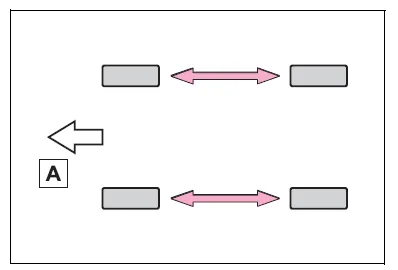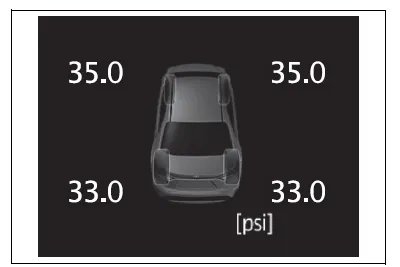Toyota Corolla (E210): Tire rotation
Rotate the tires in the order shown.

- Front
To equalize tire wear and extend tire life, Toyota recommends that tire rotation is carried out at the same interval as tire inspection.
Vehicles with a tire pressure warning system: Do not fail to initialize the tire pressure warning system after tire rotation.
Tire pressure warning system (if equipped)
Your vehicle is equipped with a tire pressure warning system that uses tire pressure warning valves and transmitters to detect low tire inflation pressure before serious problems arise.
The tire pressure warning system of this vehicle adopts a 2-type warning system.
- When "Adjust Pressure" is displayed (Normal Warning)
A warning with the tire pressure warning light and warning buzzer when there is an unknown level of low tire pressure with the appearance of the tire due to natural air leakage as well as the pressure lowering due to changes in the pressure according to the outside temperature.
- When "Immediately Check Tire when Safe" is displayed (Emergency Warning)
A warning with the tire pressure warning light and warning buzzer when there is a known level of low tire pressure with the appearance of the tire due to pressure suddenly lowering.
However, the system may not be able to detect sudden tire ruptures (bursting, etc.).
The tire pressure detected by the tire pressure warning system can be displayed on the multi-information display.

■ How to change the unit
4.2-inch display
1. Park the vehicle in a safe place and turn the engine switch off.
Changing the unit cannot be performed while the vehicle is moving.
2. Turn the engine switch to ON.
3. Select  of the
multi-information
display and then
press
of the
multi-information
display and then
press  .
.
4. Press  or
or
 to select
"Vehicle Settings" and then
press and hold .
to select
"Vehicle Settings" and then
press and hold .
5. Press  or
or
 to select
"TPWS setting" and then
press .
to select
"TPWS setting" and then
press .
6. Press  or
or
 to select
"Pressure unit setting".
to select
"Pressure unit setting".
7. Press  or
or
 to select the
desired unit and then press
.
to select the
desired unit and then press
.
7-inch display
1. Park the vehicle in a safe place and turn the engine switch off.
Changing the unit cannot be performed while the vehicle is moving.
2. Turn the engine switch to ON.
3. Select  of the multi-information
display and then
press .
of the multi-information
display and then
press .
4. Press  or
or
 to select
"Vehicle Settings" and then
press and hold .
to select
"Vehicle Settings" and then
press and hold .
5. Press  or
or
 to select
"TPWS setting" and then
press
to select
"TPWS setting" and then
press  .
.
6. Press  or
or
 to select
"Pressure unit setting".
to select
"Pressure unit setting".
7. Press  or
or
 to select the
desired unit and then press
to select the
desired unit and then press  .
.
■Routine tire inflation pressure checks
The tire pressure warning system does not replace routine tire inflation pressure checks. Make sure to check tire inflation pressure as part of your routine of daily vehicle checks.
■Tire inflation pressure
- It may take a few minutes to display the tire inflation pressure after the engine switch is turned to ON. It may also take a few minutes to display the tire inflation pressure after inflation pressure has been adjusted.
- Tire inflation pressure changes
with temperature.
The displayed values may also be different from the values measured using a tire pressure gauge.
■Situations in which the tire pressure warning system may not operate properly
- In the following cases, the tire
pressure warning system may not
operate properly.
- If non-genuine Toyota wheels are used.
- A tire has been replaced with a tire that is not an OE (Original Equipment) tire.
- A tire has been replaced with a tire that is not of the specified size.
- Tire chains, etc. are equipped.
- An auxiliary-supported run-flat tire is equipped.
- If a window tint that affects the radio wave signals is installed.
- If there is a lot of snow or ice on the vehicle, particularly around the wheels or wheel housings.
- If the tire inflation pressure is extremely higher than the specified level.
- If tires not equipped with tire pressure warning valves and transmitters are used.
- If the ID code on the tire pressure warning valves and transmitters is not registered in the tire pressure warning computer.
- Performance may be affected in
the following situations.
- Near a TV tower, electric power plant, gas station, radio station, large display, airport or other facility that generates strong radio waves or electrical noise.
- When carrying a portable radio, cellular phone, cordless phone or other wireless communication device.
- When the vehicle is parked, the time taken for the warning to start or go off could be extended.
- When tire inflation pressure declines rapidly for example when a tire has burst, the warning may not function.
■Warning performance of the tire pressure warning system
The warning of the tire pressure warning system will change in accordance with driving conditions.
For this reason, the system may give a warning even if the tire pressure does not reach a low enough level, or if the pressure is higher than the pressure that was adjusted to when the system was initialized.
Other materials:
Exterior
Doors
Locking/unlocking
Opening/closing the side windows
Locking/unlocking by using the mechanical key*1
Warning messages
Trunk
Opening from inside
Opening from outside
Warning messages
Outside rear view mirrors
Adjusting the mirror angle
Folding the mirrors
Defogging the mirrors*2
...
On–vehicle inspection
1. Inspect speedometer
check the operation.
Using a speedometer tester, inspect the speedometer fro allowable
indication error and check
the operation of the odometer.
Reference:
Notice:
tire wear and tire over or under inflation will increase the indication error.
...
Mechanical system tests
1. Perform mechanical system tests
Measure the stall speed.
The object of this test is to check the overall performance of the transaxle
and engine by measuring
the stall speeds in the d and r positions.
Notice:
Do the test at normal operating atf temperature 50 to 80 °c (122 to
...


